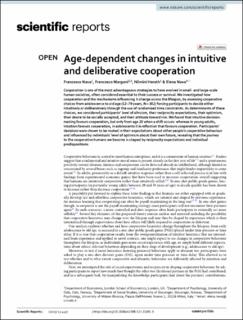| dc.contributor.author | Nava, Francesco | |
| dc.contributor.author | Margoni, Francesco | |
| dc.contributor.author | Herath, Nilmini | |
| dc.contributor.author | Nava, Elena | |
| dc.date.accessioned | 2024-03-12T11:24:57Z | |
| dc.date.available | 2024-03-12T11:24:57Z | |
| dc.date.created | 2023-04-02T21:23:57Z | |
| dc.date.issued | 2023 | |
| dc.identifier.citation | Nava, F., Margoni, F., Herath, N., & Nava, E. (2023). Age-dependent changes in intuitive and deliberative cooperation. Scientific Reports, 13(1), 4457. | en_US |
| dc.identifier.issn | 2045-2322 | |
| dc.identifier.uri | https://hdl.handle.net/11250/3121941 | |
| dc.description.abstract | Cooperation is one of the most advantageous strategies to have evolved in small- and large-scale human societies, often considered essential to their success or survival. We investigated how cooperation and the mechanisms infuencing it change across the lifespan, by assessing cooperative choices from adolescence to old age (12–79 years, N= 382) forcing participants to decide either intuitively or deliberatively through the use of randomised time constraints. As determinants of these choices, we considered participants’ level of altruism, their reciprocity expectations, their optimism, their desire to be socially accepted, and their attitude toward risk. We found that intuitive decisionmaking favours cooperation, but only from age 20 when a shift occurs: whereas in young adults, intuition favours cooperation, in adolescents it is refection that favours cooperation. Participants’ decisions were shown to be rooted in their expectations about other people’s cooperative behaviour and infuenced by individuals’ level of optimism about their own future, revealing that the journey to the cooperative humans we become is shaped by reciprocity expectations and individual predispositions. | en_US |
| dc.language.iso | eng | en_US |
| dc.publisher | Nature | |
| dc.rights | Navngivelse 4.0 Internasjonal | * |
| dc.rights.uri | http://creativecommons.org/licenses/by/4.0/deed.no | * |
| dc.title | Age‑dependent changes in intuitive and deliberative cooperation | en_US |
| dc.type | Peer reviewed | en_US |
| dc.type | Journal article | en_US |
| dc.description.version | publishedVersion | en_US |
| dc.rights.holder | The authors | en_US |
| dc.subject.nsi | VDP::Samfunnsvitenskap: 200::Psykologi: 260 | en_US |
| dc.source.pagenumber | 1-17 | en_US |
| dc.source.volume | 13 | en_US |
| dc.source.journal | Scientific Reports | en_US |
| dc.source.issue | 1 | en_US |
| dc.identifier.doi | 10.1038/s41598-023-31691-9 | |
| dc.identifier.cristin | 2139129 | |
| cristin.ispublished | true | |
| cristin.fulltext | original | |
| cristin.qualitycode | 1 | |

